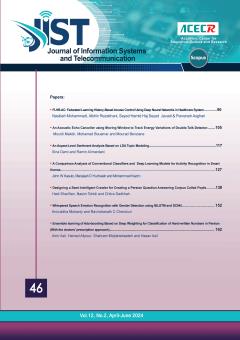-
-
List of Articles
-
Open Access Article
1 - FLHB-AC: Federated Learning History-Based Access Control Using Deep Neural Networks in Healthcare System
Nasibeh Mohammadi Afshin Rezakhani Hamid Haj Seyyed Javadi Parvaneh asghari -
Open Access Article
2 - An Acoustic Echo Canceller using Moving Window to Track Energy Variations of Double-Talk-Detector
Mouldi MAKDIR Mohamed BOUAMAR Mourad BENZIANE -
Open Access Article
3 - An Aspect-Level Sentiment Analysis Based on LDA Topic Modeling
Sina Dami Ramin Alimardani -
Open Access Article
4 - A Comparison Analysis of Conventional Classifiers and Deep Learning Model for Activity Recognition in Smart Homes based on Multi-label Classification
John Kasubi Manjaiah D. Huchaiah Ibrahim Gad Mohammad Kazim Hooshmand -
Open Access Article
5 - Designing a Semi-Intelligent Crawler for Creating a Persian Question Answering Corpus Called Popfa
Hadi Sharifian Nasim Tohidi Chitra Dadkhah -
Open Access Article
6 - Whispered Speech Emotion Recognition with Gender Detection using BiLSTM and DCNN
Aniruddha Mohanty Ravindranath C. Cherukuri -
Open Access Article
7 - Ensemble learning of daboosting based on deep weighting for classification of hand-written numbers in Persian
amir asil hamed Alipour Shahram mojtahedzadeh hasan Asil
-
The rights to this website are owned by the Raimag Press Management System.
Copyright © 2017-2025







